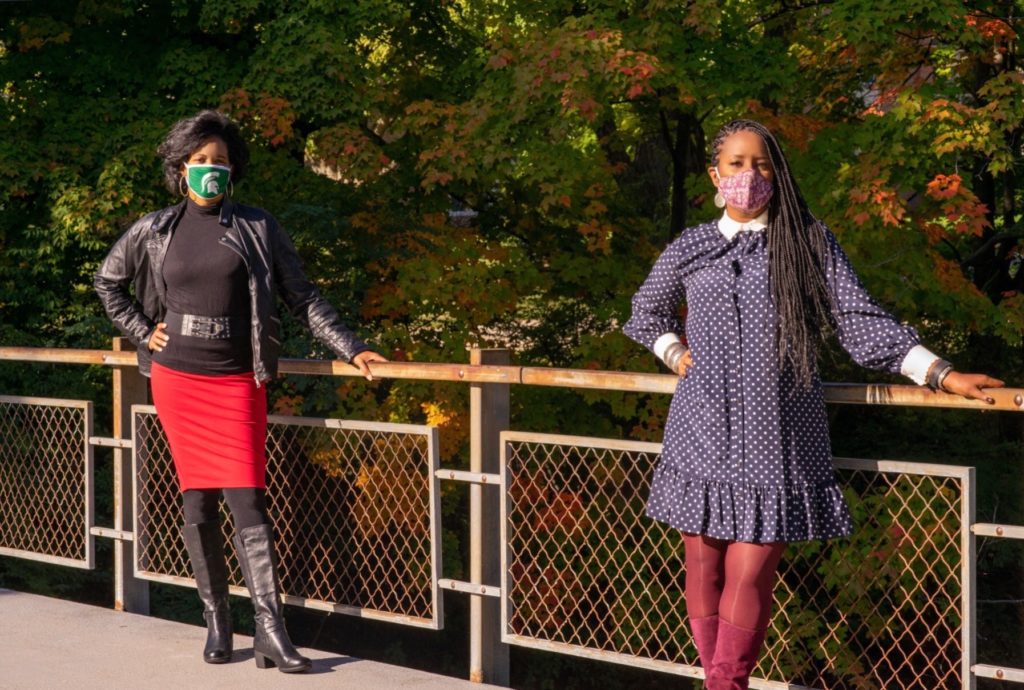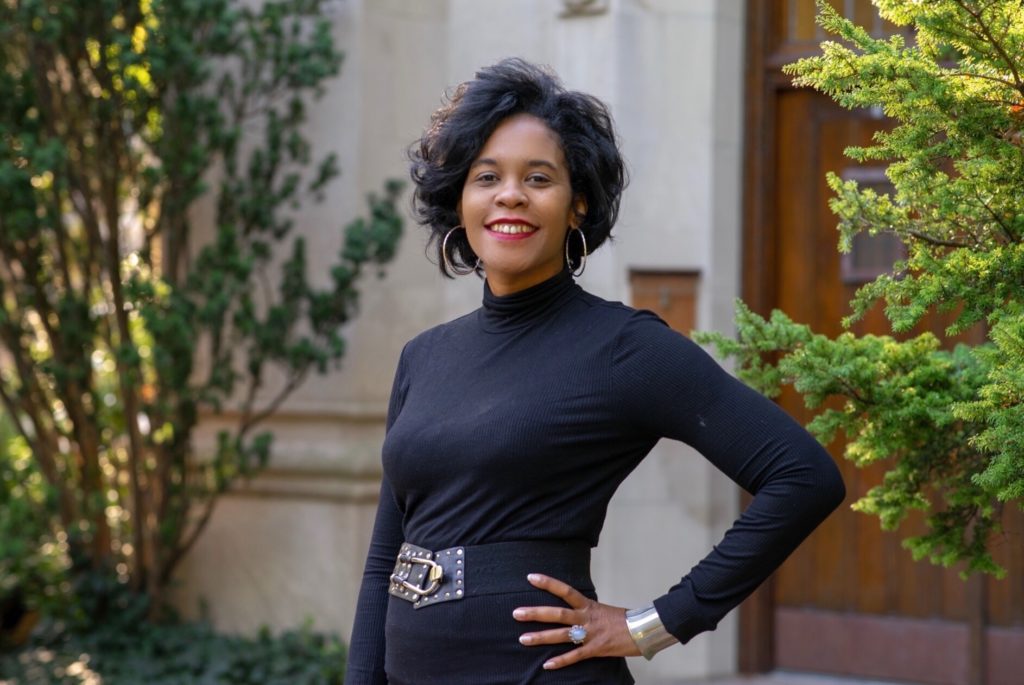
As we distance ourselves to help stop the spread of a deadly virus, a new department is being built within Michigan State University’s College of Arts & Letters — the Department of African American and African Studies (AAAS).
At the helm of this momentous effort are Ruth Nicole Brown, Inaugural Chair of AAAS, and Tamura Lomax, Founding Associate Professor.
“We are meeting, working, desiring, and actively dreaming up this new department in a global pandemic,” Brown said. “These days, the unknown is perhaps our greatest certainty. We are also newly building and that includes a great amount of uncertainty also.”
Before the two began working together, Brown said she wondered what led Lomax to find this uncertainty exciting enough to accept?
We are meeting, working, desiring, and actively dreaming up this new department in a global pandemic. These days, the unknown is perhaps our greatest certainty.
Ruth Nicole Brown, Inaugural Chair of AAAS
“This is what truly excited me about coming to MSU and working with Ruth Nicole,” Lomax explained. “We, two former Black girls, get to come together and dream new visionary Black feminist dreams while stretching existing parameters, practicing resistance, and insisting on joy, play, creativity, collectivity, complexity, particularity, accountability, and living well. That in itself is a dream.”
Their work together began by drafting a first communication to all students with a minor in AAAS.
“My desire was for the first communication to come from both Tamura and I, as the 100% appointed faculty of the department,” Brown said. “Because I value collectivity and know from previous experience that to create beyond a collaboration, often times, rethinking our relation to hierarchy is necessary. You have to show the people how you meant togetherness, as a radical act and demonstration of otherwise ways of relating. It seems to me elitist representations of expertise can be undone by the presence of more than one. And ideally, by the showing up of all involved.”

Prior to this, Brown and Lomax had not met before becoming colleagues in the new AAAS Department, but were familiar with each other’s work.
“I first heard about Ruth Nicole from a two-part interview between her, Darnell Moore, and Aimee Meredith Cox published at my site, The Feminist Wire (TFW), in December 2011, titled ‘On Black/Brown Girlhood, Black Feminism, and the Arts: A Conversation with Aimee Cox and Ruth Nicole Brown,’” Lomax said. “In the interview, she necessarily called attention to the muting of Black girls in Black feminist scholarship and praxis, thusly insisting on individuated space for Black girls. This assertion, something seemingly minute, arrested me. Ruth Nicole was in fact calling us to a space of accountability, as she was urging us to hear and to center the complex truths of Black girls, something many of us took for granted.”
At the time she had read that interview, Lomax had just completed her Ph.D. in Religion from Vanderbilt University, where she specialized in Black Religious History and Black Diaspora Studies.
We, two former Black girls, get to come together and dream new visionary Black feminist dreams while stretching existing parameters, practicing resistance, and insisting on joy, play, creativity, collectivity, complexity, particularity, accountability, and living well. That in itself is a dream.
Tamura Lomax, Founding Associate Professor
“I had spent years enthusiastically reciting the assumptive phrase, ‘Black women and girls’ throughout my readings, research, and writings,” Lomax said. “After working in corporate America for a spell where race, sex, and gender talk was viewed as politically incorrect, I was just thrilled to finally have space to freely engage in a discourse that unapologetically centered us.”
During the interview, Brown pressed readers to sit with what’s particular about Black girlhood.
“Though intrigued, I wasn’t ready,” Lomax admits. “Doing so called me to not only explore Black girls as a site of critical inquiry, but to rediscover the Black girl within me and to revisit a time in life I had long buried away. And not because I had a bad childhood. It was quite the opposite. But because America quite frankly terrorizes Black girls. That is, even the best of our experiences may also reveal simultaneous deep wells of trauma and despair. I’ve thrived because I am a dreamer…and a fighter.”
As Brown reflected on the interview, she said she never told Lomax how much she appreciated having it published on The Feminist Wire. She also had not told her that some of the writing published on The Feminist Wire had influenced her own work.

“When I teach Black Feminisms, there is one essay from The Feminist Wire that is always required, ‘I Love So That I May Teach’ by Linh Hua. It confronts unfathomable loss and heartbreak to mobilize integrated truths and holistic approaches to professing, teaching, and living that are absolutely necessary to consider and courageously practice,” Brown said.
For Lomax, she said it took her nine years after reading the interview with Brown for her to intentionally create distance between Black women and Black girls. That shift was catapulted by her most recent book project on Black boys, titled Parenting Against the Patriarchy: Raising Non-Toxic Sons in White Supremacist America, which will be published by Duke University in the near future.
“It is not happenstance that I began editing the text for my most recent book in early January with Ruth Nicole’s text, Hear Our Truths: The Creative Potential of Black Girlhood (Dissident Feminisms) (2013) in hand,” Lomax said. “Her discourse on writing in the first-person narrative voice and imagining a visionary and emancipatory Black girlhood freed me to write this book the way that I am writing it today.”
Before the Fall 2020 semester began, Brown and Lomax began working on that first communication from the new Department of African American and African Studies, which was sent on the first day of classes.
We are literally tasked with imagining and realizing a vanguard department that unapologetically centers Black feminism within the heart of Black Studies – in the midst of a deadly pandemic.
Tamura Lomax, Founding Associate Professor
“I never would have imagined this back in January, us partnering on the AAAS new build, which explicitly foregrounds Black Feminisms and ultimately Black girls – and all of our complexities,” Lomax said. “To be clear, this is sacred work in a peculiar time. And I am certain both Ruth Nicole and I are supposed to be here right now – together – doing exactly what we’re doing. We are literally tasked with imagining and realizing a vanguard department that unapologetically centers Black feminism within the heart of Black Studies – in the midst of a deadly pandemic that has reportedly killed 200,000 people (and counting) in this country since March no less. I really want us to sit with the layers of that. People are dying, living in fear of death, and cannot gather, yet we are collectively creating something fresh and new, and we are determined to do it differently – in our charter, in our structure, in our bylaws, in how we relate to one another, in our vision, in our administration, in our presencing, in our curriculum, and more.
“More, we are thinking about Black Studies, specifically for us, AAAS, in a way that intentionally foregrounds, from our inception, the question previously raised by Black feminists Beverly Guy-Sheftall, Barbara Christian, and others: where’s the space for Black women (+ Black girls) in Black Studies?”
When thinking of all that must be done to build the new department, Brown reflects on the importance of movement.
“With the new build, when learning new people, movement is required. AAAS students can rest assured in our ability to keep moving,” she said. “There’s a way to be together, and there is a way to build new worlds. Even and especially, now in the present moment when institutional discourse is reduction. And, distance is the rule. We outdid them both, as rehearsal for something that is here and is still on the way. It’s so exciting and that is another affirmation that surfaces in the doing, even as things change and even as so much is so hard, the creative energies of a powerful few are both compass and flight.
“Those tomorrows dreamt — are here, witnessing us moving, well, and collectively building anew.”


